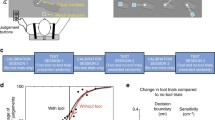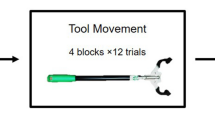Abstract
Morphology and functional aspects of the tool have been proposed to be critical factors modulating tool use-induced plasticity. However, how these aspects contribute to changing body representation has been underinvestigated. In the arm bisection task, participants have to estimate the length of their own arm by indicating its midpoint, a paradigm used to investigate the representation of the metric properties of the body. We employed this paradigm to investigate the impact of different actions onto tool embodiment. Our findings suggest that a training requiring actions mostly with proximal (shoulder) or distal (wrist) parts induces a different shift in the perceived arm midpoint. This effect is independent of, but enhanced by, the use of the tool during the training and in part influenced by specific demands of the task. These results suggest that specific motor patterns required by the training can induce different changes of body representation, calling for rethinking the concept of tool embodiment, which would be characterized not simply by the morphology of the tools, but also by the actions required for their specific use.



Similar content being viewed by others
References
Arbib MA, Bonaiuto JB, Jacobs S, Frey SH (2009) Tool use and the distalization of the end-effector. Psychol Res 73(4):441–462
Bassolino M, Serino A, Ubaldi S, Làdavas E (2010) Everyday use of the computer mouse extends peripersonal space representation. Neuropsychologia 48(3):803–811
Bassolino M, Finisguerra A, Canzoneri E, Serino A, Pozzo T (2015) Dissociating effect of upper limb non-use and overuse on space and body representations. Neuropsychologia 70:385–392
Berti A, Frassinetti F (2000) When far becomes near: re-mapping of space by tool use. J Cogn Neurosci 12(3):415–420
Bolognini N, Casanova D, Maravita A, Vallar G (2012) Bisecting real and fake body parts: effects of prism adaptation after right brain damage. Front Hum Neurosci 6:154
Canzoneri E, Ubaldi S, Rastelli V, Finisguerra A, Bassolino M, Serino A (2013) Tool-use reshapes the boundaries of body and peripersonal space representations. Exp Brain Res 228(1):25–42
Cardinali L, Frassinetti F, Brozzoli C, Urquizar C, Roy AC, Farne A (2009) Tool-use induces morphological updating of the body schema. Curr Biol 19(12):R478–R479
Cardinali L, Jacobs S, Brozzoli C, Frassinetti F, Roy AC, Farnè A (2012) Grab an object with a tool and change your body: tool-use-dependent changes of body representation for action. Exp Brain Res 218(2):259–271
Cardinali L, Brozzoli C, Finos L, Roy AC, Farnè A (2016) The rules of tool incorporation: tool morpho-functional & sensori-motor constraints. Cognition 149:1–5
Cohen J (1990) Things i have learned (so far). Am Psychol 45(12):1304–1312
Cohen J (1994) The earth is round (p < 0.05). Am Psychol 49(12):997–1003
D’Angelo M, di Pellegrino G, Seriani S, Gallina P, Frassinetti F (2018) The sense of agency shapes body schema and peripersonal space. Sci Rep 8:13847
de Vignemont F (2010) Body schema and body image–pros and cons. Neuropsychologia 48(3):669–680
Farné A, Serino A, Ladavas E (2007) Dynamic size-change of peri-hand space following tool-use: determinants and spatial characteristics revealed through cross-modal extinction. Cortex 43(3):436–443
Faul F, Erdfelder E, Lang AG, Buchner A (2007) G*Power 3: a flexible statistical power analysis program for the social, behavioral, and biomedical sciences. Behav Res Methods 39(2):175–191
Gallagher S (2005) How the body shapes the mind. Claredon Press, Oxford
Gallese V, Sinigaglia C (2010) The bodily self as power for action. Neuropsychologia 48(3):746–755
Garbarini F, Fossataro C, Berti A, Gindri P, Romano D, Pia L, Neppi-Modona M (2015) When your arm becomes mine: pathological embodiment of alien limbs using tools modulates own body representation. Neuropsychologia 70:402–413
Green P, Macleod CJ (2016) SIMR: an R package for power analysis of generalized linear mixed models by simulation. Methods Ecol Evol 7(4):493–498
Head H, Holmes G (1911) Sensory disturbances from cerebral lesions. Brain 34(2–3):102–254
Higuchi S, Imamizu H, Kawato M (2007) Cerebellar activity evoked by common tool-use execution and imagery tasks: an fMRI study. Cortex 43(3):350–358
Hoenig JM, Heisey DM (2001) The abuse of power: the pervasive fallacy of power calculations for data analysis. Am Stat 55(1):19–24
Holmes NP, Sanabria D, Calvert GA, Spence C (2007) Tool-use: capturing multisensory spatial attention or extending multisensory peripersonal space? Cortex 43(3):469–489
Holmes NP, Calvert GA, Charles S (2008) Tool use changes multisensory interactions in seconds: evidence from the crossmodal congruency task. Brain Behav Immun 22(5):629–629
Imamizu H, Miyauchi S, Tamada T, Sasaki Y, Takino R, PuÈtz B, … & Kawato M (2000) Human cerebellar activity reflecting an acquired internal model of a new tool. Nature 403(6766):192–195
Iriki A, Tanaka M, Iwamura Y (1996) Coding of modified body schema during tool use by macaque postcentral neurones. Neuroreport 7(14):2325–2330
Johnson-Frey SH, Newman-Norlund R, Grafton ST (2005) A distributed left hemisphere network active during planning of everyday tool use skills. Cereb Cortex 15(6):681–695
Longo MR, Haggard P (2010) An implicit body representation underlying human position sense. PNAS 107(17):1–6
Maravita A, Iriki A (2004) Tools for the body (schema). Trends Cogn Sci 8(2):79–86
Maravita A, Husain M, Clarke K, Driver J (2001) Reaching with a tool extends visual–tactile interactions into far space: evidence from cross-modal extinction. Neuropsychologia 39(6):580–585
Maravita A, Spence C, Kennett S, Driver J (2002) Tool-use changes multimodal spatial interactions between vision and touch in normal humans. Cognition 83(2):B25–B34
Masson MEJ, Loftus GR (2003) Using confidence intervals for graphically based data interpretation. Can J Exp Psychol 57(3):203–220
Miller LE, Longo MR, Saygin AP (2014) Tool morphology constrains the effects of tool use on body representations. J Exp Psychol Hum Percept Perform 40(6):2143
Miller LE, Cawley-Bennett A, Longo MR, Saygin AP (2017a) The recalibration of tactile perception during tool-use is body-part specific. Exp Brain Res 235(10):2917–2926
Miller LE, Longo MR, Saygin AP (2017b) Visual illusion of tool use recalibrates tactile perception. Cognition 162:32–40
Oakley JE, O’Hagan A (2004) Probabilistic sensitivity analysis of complex models: a Bayesian approach. J R Stat Soc Ser B Stat Methodol 66(3):751–769
Pegna AJ, Petit L, Caldara-Schnetzer A-S, Khateb A, Annoni J-M, Sztajzel R, Landis T (2001) So near yet so far: neglect in far or near space depends on tool use. Ann Neurol 50:820–822
Rossetti A, Romano D, Bolognini N, Maravita A (2015) Dynamic expansion of alert responses to incoming painful stimuli following tool use. Neuropsychologia 70:486–494
Sengül A, van Elk M, Rognini G, Aspell JE, Bleuler H, Blanke O (2012) Extending the body to virtual tools using a robotic surgical interface: evidence from the crossmodal congruency task. PloS One 7(12):e49473
Sposito AV, Bolognini N, Vallar G, Posteraro L, Maravita A (2010) The spatial encoding of body parts in patients with neglect and neurologically unimpaired participants. Neuropsychologia 48(1):334–340
Sposito A, Bolognini N, Vallar G, Maravita A (2012) Extension of perceived arm length following tool-use: clues to plasticity of body metrics. Neuropsychologia 50(9):2187–2194
Team RC (2016) R: a language and environment for statistical computing. Vienna, Austria, 2016
Tosi G, Romano D, Maravita A (2018) Mirror box training in hemiplegic stroke patients affects body representation. Front Hum Neurosci 11:617
Westfall J, Kenny DA, Judd CM (2014) Statistical power and optimal design in experiments in which samples of participants respond to samples of stimuli. J Exp Psychol General 143(5):2020
Author information
Authors and Affiliations
Corresponding authors
Additional information
This study shows that embodiment of tools is modulated by the specific motor pattern required by the training. These findings are particularly relevant because they challenge the concept of tool embodiment, which would be characterized not simply by the morphology of the different tools (i.e. length, shape), but also by the actions required for their specific use.
Rights and permissions
About this article
Cite this article
Romano, D., Uberti, E., Caggiano, P. et al. Different tool training induces specific effects on body metric representation. Exp Brain Res 237, 493–501 (2019). https://doi.org/10.1007/s00221-018-5405-1
Received:
Accepted:
Published:
Issue Date:
DOI: https://doi.org/10.1007/s00221-018-5405-1




